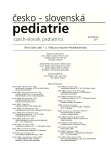Koncentrace neuron-specifické enolasy v séru jako prediktor mortality u dětí s traumatickým poraněním mozku
Authors:
J. Žurek; M. Fedora
Authors‘ workplace:
Fakultní nemocnice Brno
přednosta doc. MUDr. M. Fedora, Ph. D.
; Klinika dětské anesteziologie a resuscitace, Lékařská fakulta, Masarykova univerzita
Published in:
Čes-slov Pediat 2011; 66 (2): 68-74.
Category:
Original Papers
Overview
Cíl:
Cílem studie byly korelace hladin neuron-specifické enolasy (NSE) v séru s mortalitou, Glasgow Outcome Scale (GOS) a délkou hospitalizace u dětí s traumatickým poraněním mozku (TBI).
Materiál a metody:
Protokol studie byl schválen Etickou komisí Fakultní nemocnice v Brně. V období od května 2007 do října 2009 jsme do prospektivní observační studie zahrnuli 63 pacientů s poraněním mozku. TBI bylo verifikována počítačovou tomografií. Vzorky venózní krve byly odebrány vždy při přijetí a následně každých 24 hodin po dobu 6 následujících dní. Sérové koncentrace neuron-specifické enolasy byly stanoveny elektrochemiluminiscencí. Šest měsíců po úrazu bylo podle protokolu stanoveno outcome na základě GOS.
Výsledky:
Hodnoty NSE jsou signifikantně vyšší u pacientů, kteří zemřeli (medián 61,84; min 25,55 – max. 271,3 μg/l; p <0,02) ve srovnání s pacienty, kteří přežili (medián 33,51; min 12,51 – max. 97,9 μg/l). Signifikantní odlišnost dynamiky tohoto proteinu byla pouze u pacientů, kteří zemřeli, přičemž vzestup je stále patrný během prvních dvou dnů. U přeživších tyto hodnoty od začátku klesaly. Ve čtvrtém dnu došlo u několika pacientů k mírnému zvýšení hodnot NSE, nicméně toto zvýšení se v celkovém průměru neprojevilo jako tzv. „second peak“. Nebyl nalezen žádný rozdíl ve vztahu k délce hospitalizace.
Závěr:
Biomarker neuron-specifická enolasa může být potenciálně použit jako kvantitativní měřítko úspěšnosti terapie poranění mozku a může sloužit jako objektivní marker predikce mortality a outcome.
Klíčová slova:
neuron-specifická enolasa, traumatické poškození mozku, biomarker, děti
Sources
1. www.uzis.cz/rychle-informace/vyvoj-urazovosti-deti-roku-2006.
2. Lékařské listy 2/2010 Mladá fronta a.s., ISSN 0044-1996.
3. Giza CC, Mink RB, Madikians A. Pediatric traumatic brain injury: not just little adults. Curr Opin Crit Care 2007; 13 : 143–152.
4. Liu MC, Akle V, Zheng W, et al. Comparing calpain - and caspase-3-mediated degradation patterns in traumatic brain injury by differential proteome analysis. Biochem J 2006; 394 : 715–725.
5. Bakay RA, Ward AA Jr. Enzymatic changes in serum and cerebrospinal fluid in neurological injury. J Neurosurg 1983; 58 : 27–37.
6. Kochanek PM, Berger RP, Bayir H, et al. Biomarkers of primary and evolving damage in traumatic and ischemic brain injury: diagnosis, prognosis, proviny mechanisms, and therapeutic decision making. Curr Opin Crit Care 2008; 14 : 135–141.
7. Moore BW, McGregor D. Chromatographic and electrophoretic fractionation of soluble proteins of brain and liver. J Biol Chem 1965; 240 : 1647–1653.
8. Cooper EH. Neuron-specific enolase. Int J Biol Markers 1994; 4 : 205–210.
9. Bandyopadhyay S, Hennes H, Gorelick MH, et al. Serum neuron-specific enolase as a predictor of short-term outcome in children with closed traumatic brain injury. Acad Emerg Med 2005; 12 : 732–738.
10. Berger RP, Adelson PD, Pierce MC, et al. Serum neuron-specific enolase, S100B, and myelin basic protein concentrations after inflicted and noninflicted traumatic brain injury in children. J Neurosurg 2005; 103(Suppl 1): 61–68.
11. Pelinka LE, Hertz H, Mauritz W, et al. Nonspecific increase of systemic neuron-specific enolase after trauma: clinical and experimental findings. Shock 2005; 24 : 119–123.
12. Piazza O, Cotena S, Esposito G, et al. S100B is a sensitive but not specific prognostic index in comatose patients after cardiac arrest. Minerva Chir 2005; 60 : 477–480.
13. Teasdale G, Jennett B. Assessment of coma and impaired consciousness. A practical scale. Lancet 1974; 2 : 81–84.
14. Tepas J, et al. The Pediatric Trauma Score as a predictor of injury severity in the injured child. J Pediat Surg 1987; 22 : 14–18.
15. Jennett B, Bond M. Assessment of outcome after severe brain damage. Lancet 1975; 1 : 480–484.
16. Herrmann M, Johnsson P, Romner B. Molecular markers of brain damage: current state and future perspectives. Restor Neurol Neurosci 2003; 21 : 75–77.
17. Dauberschmidt R, Marangos P, Zinsmeyer J, et al. Severe head trauma and the changes of concentration of neuron-specific enolase in plasma and in cerebrospinal fluid. Clin Chim Acta 1983; 131 : 165–170.
18. Bittigau P, Sifringer M, Pohl D, et al. Apoptotic neurodegeneration following trauma is markedly enhanced in the immature brain. Ann Neurol 1999; 45 : 724–735.
19. Nygaard O, Langbakk B, Romner B. Neuron-specific enolase concentrations in serum and cerebrospinal fluid in patients with no previous history of neurological disorder. Scand J Clin Lab Invest 1998; 58 : 183–186.
20. Ruppel R, Kochanek P, Adelson P, et al. Excitotoxicity after severe traumatic brain injury in infants and children: the role of child abuse. J Pediatr 2001; 138 : 18–25.
21. Clark R, Kochanek P, Adelson P, et al. Increases in bcl-2 protein in cerebrospinal fluid and evidence for programmed cell death in infants and children after severe traumatic brain injury. J Pediatr 2000; 137 : 197–204.
22. Janesko K, Satchell M, Kochanek P, et al. IL-1 converting enzyme (ICE), IL-1, and cytochrome C in CSF after head injury in infants and children. J Neurotrauma 2000; 17 : 956.
23. Beers SR, Berger RP, Adelson PD. Neurocognitive outcome and serum biomarkers in inflicted versus non-inflicted traumatic brain injury in young children. J Neurotrauma 2007; 24 : 97–105.
24. Kruijk JR, Leffers P, Menheere PPCA, Meerhoff S, Twijnstra A. S-100B and neuron-specific enolase in serum of mild traumatic brain injury patients. Acta Neurol Scand 2001; 103 : 175–179.
25. Pelinka LE, Jafardamar M, Redl H, et al. Neuronspecific enolase is increased in plasma after hemorrhagic shock and after bilateral femur fracture without traumatic brain injury in the rat. Shock 2004; 22 : 88–91.
Labels
Neonatology Paediatrics General practitioner for children and adolescentsArticle was published in
Czech-Slovak Pediatrics

2011 Issue 2
Most read in this issue
- Extraezofágový reflux – otorinolaryngologické komplikácie gastroezofágového refluxu
- Léčíme pacienty s kryptorchismem v doporučeném věku?
- Krikofaryngeálna achalázia ako príčina chronického dráždivého kašľa u dojčaťa
- Reaktivní hyperemický index v detekci endoteliální dysfunkce u dětí – pilotní studie
